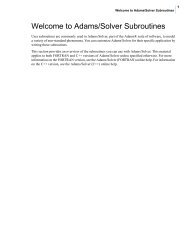Create successful ePaper yourself
Turn your PDF publications into a flip-book with our unique Google optimized e-Paper software.
<strong>ICAM</strong> <strong>Virtual</strong> <strong>Machine</strong> ® Version 19.0 <strong>Virtual</strong> <strong>Machine</strong> Reference, Menu Bar<br />
Simulation»Construct Axis (Quest only)<br />
4.3.7 Simulation»Construct Axis (QUEST only)<br />
Provides the ability to add<br />
axes (i.e., things that<br />
move) to the model. These<br />
menu selections are only<br />
available in QUEST. The “<strong>Machine</strong>s” section must be opened before you can add axes to the<br />
model. The VM Construct tool bar provides buttons (as shown circled above) for each of the axis<br />
types that can be constructed.<br />
All axes share some common parameters, listed below:<br />
� Name: Axis names are used in the Model Navigator in QUEST. Linear, Rotary and Curve<br />
axis names also appear in (and can be controlled from) the QUEST lower right Axes window<br />
as well as the VM Controller Axes window in CERUN and GENER. VM assigns default<br />
names when objects are created. You should change the default to something that is<br />
both short and meaningful.<br />
� Unit: Specifies the unit of measure for all non-rotary values (angles are always specified<br />
in degrees).<br />
� Position: Specifies the X, Y and Z axis position of the origin of the current axis in relation<br />
to the origin and rotational alignment of the parent object. When world coordinates<br />
are selected (Simulation»Use World CS), the position of the axis is shown in world coordinates<br />
instead of relative to the parent object. When constructing an axis, the mouse<br />
pointer can be used to define the axis origin.<br />
� OK button: Creates the axis as defined.<br />
� Cancel button: Ignores this axis creation request.<br />
� Apply button: Updates the simulation window to show the effects of the latest changes.<br />
� Rotate button: Use this button to rotate the entity to its required final orientation. When<br />
an entity is rotated, anything attached below this entity in the Navigator will be defined in<br />
the new frame of rotation.<br />
Linear, Rotary and Curve axes share the following additional parameters:<br />
� Range: Specifies the Minimum and Maximum travel extent of the axis with respect to the<br />
axis origin position. The range does not have to include the zero position.<br />
� Slave axis to: Specifies the name of another axis that will be used to control the current<br />
one. When the named axis moves, the current axis will also be moved. You can specify a<br />
Scaling factor to change the proportion of motion, and even the direction (by specifying<br />
a negative scale factor). An axis that is slaved will not appear in the QUEST lower right<br />
Axes window or the VM Controller Axes window in CERUN and GENER. Motion of a<br />
slaved axis is only possible by moving the parent axis (i.e., the one the axis is slaved to).<br />
� Default position: Specifies the position the axis will be set to when the model is loaded,<br />
or when the axis position is reset to its default.<br />
When you add a new axis, it will appear in the lower right “Axes” window. The axis name will<br />
also appear in the Model Navigator, attached as a child (below) the object that was selected (in<br />
the Navigator) when the axis was created. You can move the axis to a new position in the<br />
96 <strong>ICAM</strong> Technologies Corporation – Proprietary















